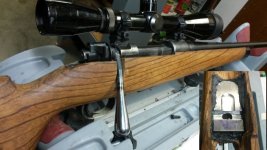ligonierbill
New member
So I bought a nice looking sporterized Mauser (8mm-06) with an especially good looking stock. A previous owner did a real neat bedding job, including the entire barrel channel. Now, I always thought that only the first few inches of the barrel, if that, should be bedded, leaving the rest of the barrel free floating or at least free of pressure points.
I'm still working on loads, but this gun groups very poorly so far. Barrel and rifling look good. It's the original military barrel, and every step is impressed in resin. Before I get out my rasp, is this a likely cause of my poor groups?
I'm still working on loads, but this gun groups very poorly so far. Barrel and rifling look good. It's the original military barrel, and every step is impressed in resin. Before I get out my rasp, is this a likely cause of my poor groups?

